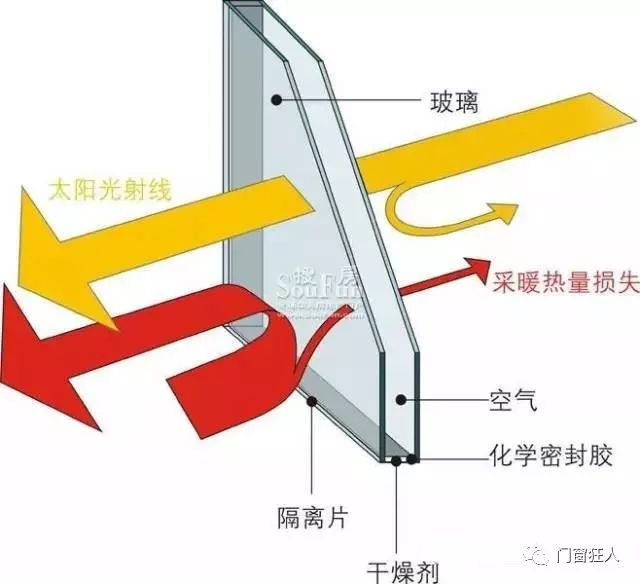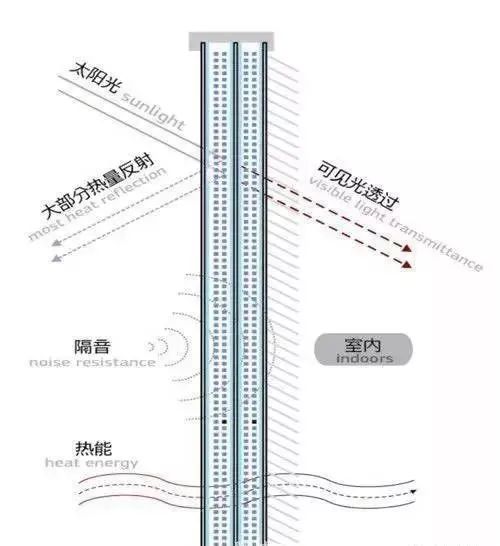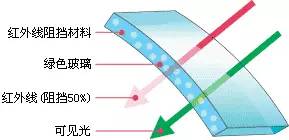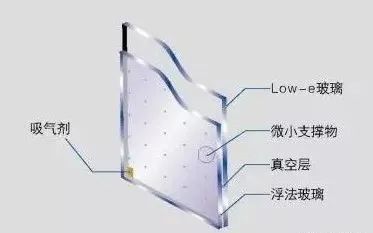As transparent materials, glass is widely used in construction, transportation, shipping, aviation, refrigeration and other industries. It is not only a good transparent material but also a good heat conductance material. No matter which field the glass is applied to, heat conduction through the glass will occur, and most of the heat conduction through the glass is energy loss. For example, the energy loss caused by sheet glass used in buildings accounts for a large proportion. According to the data, ordinary glass is applied to buildings, 1/3 of the energy is lost through the conduction of glass.
At present, in today's world energy shortage, energy conservation has become a trend. Reducing the energy loss through glass has been paid more and more attention by architects and building users, almost all architects hope to minimize the losses on the building through some way so as to minimize the energy consumption of the building. Reducing energy loss through glass has been put on the agenda. In fact, energy-saving glass has made great progress in recent years, but people's understanding of glass is not very comprehensive, so it is very important to master the energy-saving characteristics of glass to correctly select glass varieties.
1. Main parameters of glass energy saving evaluation
there are usually three forms of heat transfer in nature: convection, radiation and conduction. Since glass is a transparent material, in addition to the above three forms, the heat transfer through glass also includes direct transmission of solar energy in the form of light radiation. The parameters to measure the energy propagation through glass include thermal conductivity and K value (called U value in the United States), solar transmittance, shading coefficient, relative thermal gain, etc.
1.1 k value
the K value indicates that under certain conditions, the heat passes through the glass per unit area (usually 1m 2), unit temperature difference (usually refers to the difference between indoor temperature and outdoor temperature is generally 1 ℃ or 1K), the number of Joules transmitted per unit time. The unit of K value is usually W/m. 2 k. K value is a function of conduction heat, convection heat and radiant heat of glass, which is the comprehensive embodiment of these three heat dissipation modes. The larger the k value of glass, the worse its heat insulation ability and the more energy loss through glass.

1.2 solar energy parameters
there are actually two parts of solar energy transmitted through glass, one is the energy through which sunlight passes directly through glass; The other is that when sunlight passes through glass, part of the energy is absorbed by glass and converted into heat energy, A part of the heat energy enters the room again. There are three concepts to define:
(1) solar transmittance
the energy of sunlight passing through the glass at the normal incident angle accounts for the percentage of the incident energy of the whole sunlight;
(2) total solar transmittance
the sum of the energy that sunlight enters the room directly through the glass and the energy that sunlight enters the room twice after being absorbed and converted into heat energy by the glass accounts for the percentage of the incident energy of the whole sunlight.
(3) solar reflectivity
the energy reflected by all surfaces (single glass has two surfaces and hollow glass has four surfaces) accounts for the percentage of incident energy.
1.3 shading coefficient
shielding coefficient is defined relative to 3mm colorless transparent glass, which is regarded as 1 when the total solar transmittance of 3mm colorless transparent glass (the total solar transmittance of 3mm colorless transparent glass is 0.87) the relative value of other glass and its formation, that is, the total solar transmittance of glass divided by 0.87.
1.4 Relative thermal gain
it is used to reflect the index of comprehensive energy saving of glass. It refers to the unit area of penetration (3mm transparent, 1m) under certain conditions, that is, when the temperature difference between indoor and outdoor is 15℃. 2) glass at Earth latitude 30 O at sea level, the sum of the heat radiation directly received from the sun and the Heat passed into the room through the glass. That is, the indoor and outdoor temperature difference is 15 O the heat transfer through the glass at C plus the latitude of the Earth is 30 O solar Radiant heat 630w/m 2 the product of the masking coefficient. The greater the relative heat gain, the more heat that the outside world enters the room in summer, the worse the energy-saving effect of glass. The real thermal gain of glass is determined by the Earth latitude, season, angle formed by glass and sunlight and the performance of glass. The main factors affecting the thermal gain are the control ability of glass to solar energy, namely the shielding coefficient and the thermal insulation ability of glass.
The relative thermal gain is especially suitable for measuring the usage of sun-facing glass in areas with low latitude and long sunshine time, because this index is given when the outdoor temperature is higher than the indoor temperature, the outdoor heat flow flows to the indoor and the solar energy also enters the indoor at the same time.
When glass is used for parts without solar radiation, the index reflecting the thermal insulation capacity of glass is only k value.

2. Main varieties of energy-saving glass
with the continuous progress of technology, there are more and more varieties of glass. At present, the main varieties for energy saving are heat absorbing glass, coated glass, hollow glass, vacuum glass, etc.
2.1 heat absorbing glass

heat absorbing glass is to add metal ions into the glass body to selectively absorb solar energy and present different colors at the same time, the energy saving of heat absorbing glass is to convert light energy into heat energy when sunlight passes through the glass and be absorbed by the glass. Heat energy is emitted in the form of convection and radiation so as to reduce solar energy entering the room.
2.2 coated glass
there are two main applications of coated glass in architecture, namely heat reflective glass (also known as Solar Control glass) and low radiation glass.
Heat reflective glass is coated with metal, nonmetal and oxide films on the glass surface to make it have certain reflection effect, solar energy can be reflected back to the atmosphere to prevent solar energy from entering the room so that solar energy is not converted into heat energy indoors. The less solar energy enters the room, the less air conditioning load will be. The higher the reflectivity of heat reflecting glass, the stronger its control over solar energy, however, the visible light transmittance of glass will decrease with the increase of the reflectivity, which will affect the lighting effect. If the reflectivity of glass is too high, the problem of light pollution may occur.
The emissivity of sheet glass is relatively high, usually 0.84. Low-radiation glass is to reduce the heat loss by coating low-radiation coating on the glass surface so that the surface emissivity is lower than that of ordinary glass, thus achieving the goal of energy saving by reducing the heating cost. An important indicator to measure the energy saving effect of low-radiation glass is emissivity. The lower the emissivity, the less radiation loss occurs through the glass surface, the better the energy saving effect of the glass.
2.3 hollow glass.

Hollow glass reduces the convection and conduction heat transfer of glass due to the formation of a certain thickness between the two pieces of glass and the restriction of flowing air or other gas layers, therefore, it has better heat insulation capability. For example, a hollow glass composed of two 5mm ordinary glasses and an air layer with a thickness of 10mm in the middle layer is convection heat transfer when heat flow is perpendicular to the glass, conduction heat transfer, radiation heat transfer accounts for about 2%, 38% and 60% of the total heat transfer. At the same time, coated glass and other energy-saving glass can also be used for the single piece of insulating glass, the advantages of these glasses can be concentrated on insulating glass, that is to say, insulating glass can also combine its own advantages with coated glass, thus playing a better energy-saving role. For example, the k value of 9mm hollow glass composed of a layer of 5mm thick low radiation glass with a surface emissivity of 0.2 and a layer of ordinary glass with a thickness of 5mm is about 2.1W/m. 2 k. If a low-radiation glass with an emissivity of 0.08 is used and the air in the air layer is replaced by argon, the thickness of the air layer is 12mm, and its K value can reach 1.4W/m. 2 k. If heat reflecting glass is selected on the outer part of insulating glass, it also has the function of controlling solar energy.
2.4 vacuum glass

vacuum glass is the glass with the best energy saving effect at present. Vacuum glass forms a vacuum between two sealed pieces of glass so that the conduction heat between glass and glass is close to zero, at the same time, at least one single piece of vacuum glass is low radiation glass. Low-radiation glass can reduce radiation heat transfer, so the heat transfer through vacuum glass has little convection, radiation and conduction, and the energy saving effect is very good, but the domestic production capacity has not yet been formed.
3. Selection of energy-saving glass
with the continuous development of glass processing technology, the range of options is becoming larger and larger, however, no matter which clock glass is chosen, whether the glass can effectively control solar energy and heat insulation or energy conservation should be considered in an important position. If the glass can minimize energy loss in use, the appropriate glass must be selected according to the needs. When choosing to use energy-saving glass, the glass variety should be determined according to the position of the glass: the glass with long sunshine time and sunny surface should try to control solar energy into the room to reduce the air conditioning load, it is better to choose heat reflecting glass or heat absorbing glass and insulating glass composed of heat reflecting glass or heat absorbing glass; The glass of cold area or back positive surface should mainly control heat conduction, try to choose hollow glass or low-radiation glass. Only by choosing glass according to local conditions can energy-saving glass give full play to its energy-saving characteristics.






